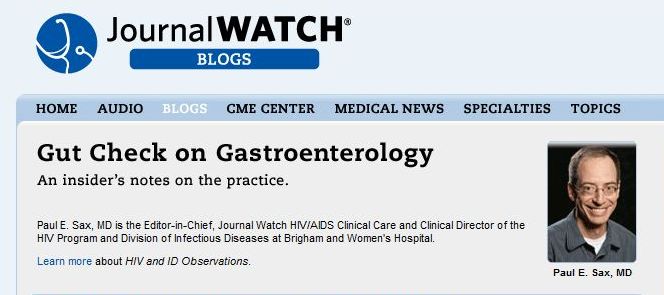An ongoing dialogue on HIV/AIDS, infectious diseases,
March 27th, 2012
Latest Guidelines Recommend HIV Treatment for All
From the key “What’s New in the Guidelines” section of today’s Department of Health and Human Services update:
ART is recommended for all HIV-infected individuals. The strength of this recommendation varies on the basis of pretreatment CD4 cell count.
This recommendation replaces a rather confusing categorization on when to start ART that, not surprisingly, was widely misinterpreted — fortunately, it now has been retired in favor of this much clearer statement.
The main reasons for the change were 1) greater appreciation of the dangers of uncontrolled viral replication (see this paper, for example) and 2) the data from 052 confirming the powerful effect HIV treatment has on preventing transmission.
My personal experience is that the latter has turned out to be the main driver of early HIV treatment in clinical practice. When my patients with high CD4 cell counts are informed of this benefit, they have almost uniformly become more motivated to start treatment.
Perhaps that’s no surprise, but it’s important to remember that what was widely considered a “public health” benefit of ART seems to have personal benefits for most individuals as well. People prefer being less contagious to others.
Now let’s see if we can make this treatment happen — it sure will be a challenge, as lots of people with HIV are not even in care, and won’t be having these discussions with their providers.
March 22nd, 2012
More Confusion on Anal Cancer Screening
Screening for anal cancer in men who have sex with men (MSM) — with pap smears, high resolution anoscopy, with whatever test — is quite the quagmire.
As I’ve mentioned before, the proponents of screening cite the success of cervical cancer screening and the startling high rates of anal cancer among HIV+ MSM as reason enough for doing something.
(Exactly what we should be doing is far from clear.)
The naysayers, who are much less vocal, say there is no evidence that this screening actually reduces the rate of anal cancer, which is of course the endpoint of interest.
Now, over in Lancet Oncology, comes this paper entitled, “Anal human papillomavirus infection and associated neoplastic lesions in men who have sex with men: a systematic review and meta-analysis.”
After reviewing a dizzying amount of data, the authors conclude:
Anal HPV and anal cancer precursors were very common in MSM. However, on the basis of restricted data, rates of progression to cancer seem to be substantially lower than they are for cervical pre-cancerous lesions. Large, good-quality prospective studies are needed to inform the development of anal cancer screening guidelines for MSM.
Not to beat a dead horse here, but the fact remains that just because we can screen for pre-cancerous lesions, doesn’t mean we should.
(For more on this fascinating dilemma, read this op-ed piece. Or this recent survey.)
And it is notable that two established HIV guidelines — those for prevention of opportunistic infections and for HIV primary care — do not endorse anal pap smear screening, awaiting just the sort of prospective studies called for in this paper.
March 22nd, 2012
Identity Crisis
As some of you might have noticed, due to a web snafu here at Mass Medical Society, I was briefly a gastroenterologist earlier this week:
Unfortunately, I don’t think this translated in a higher paycheck, even though scoping is much more lucrative than doing ID consults.
And while HIV and ID Observations is admittedly a blah name for a blog — fresh ideas anyone? — Gut Check on Gastroenterology is already taken!
March 15th, 2012
CROI 2012 Really Rapid Review — with CROI 2013 Dates!
Some highly subjective highlights — a Really Rapid Review™– from this year’s Number One Greatest Super Scientific HIV Conference, the 19th Conference on Retroviruses and Opportunistic Infections (CROI), which ended last week in Seattle:
- Need more evidence that maintaining a CD4 cell count > 500 is beneficial? This compelling analysis from the SMART and ESPRIT studies found that among virologically suppressed, ART-treated subjects with CD4 > 500, there was no evidence of a higher mortality rate compared to the general population (standardized mortality ratio, 1.0). Not so for CD4s 350-500, by the way.
- Of course, most patients don’t start ART until their CD4 is below 500, but as shown in this global view, starting CD4s have improved dramatically since 2002 — pretty much everywhere. Despite this improvement, the only country where the average starting CD4 is > 300 is the USA. Lots of work still to do here.
- Related: the San Francisco policy of recommending ART for all with HIV as a public health measure has substantially raised the CD4 at treatment initiation in that city. Suspect this will eventually turn out the be the case nationally as well, now that treatment as prevention has become more broadly accepted.
- Based on this CDC study, only 44% of patients diagnosed with HIV in the United States are receiving care. We’ve heard this story before, but it’s still a shock — and worth remembering that the number of people diagnosed with HIV and not in care greatly exceeds those who are not diagnosed. How to bring the 56% back into care is obviously an urgent challenge for us.
- Why did the FEM-PrEP study fail to show protection of TDF/FTC? As suspected, poor adherence was the answer — detectable drug levels were found in fewer than 50% of infected women assigned to active drug (mystery solved). These results reinforce my gut feeling about PrEP — namely, that it will be a niche intervention, not one that can be broadly implemented.
- Not many clinical trials of ART at this CROI, but the meeting featured results of two major trials on the coformulated TDF/FTC/elvitegravir/cobicistat — or “quad” — single-pill treatment. These studies demonstrated it was non-inferior to recommended regimens — TDF/FTC/EFV and TDF/FTC/ATV/r. The “quad” (what will it ultimately be called?) has been submitted for FDA review. (Disclosure: I presented the results on the former.)
- 96-week coverage of phase II data on dolutegravir — and it still looks really good. Phase III data later this year?
- D:A:D study on cardiovascular risk of atazanavir? “No worries,” as people of a certain age (e.g., all our ID fellows) like to say. And let me be the first (or next) person to question the use of colons between letters in “D:A:D” — why? And did they realize it would make it harder to search?
- D:A:D again, this time on renal issues. The culprits? TDF, ATV/r, and LPV/r. We’ve heard this before, with EuroSIDA (you’ve got to figure that some EuroSIDA patients are also in D:A:D) and other cohorts. Bottom line is that in older, medically complex patients with other co-morbid risk factors for renal disease, the TDF + boosted PI regimen is the one to monitor closely.
- The tenofovir pro-drug 7340 has plenty of antiviral activity. Plus, the low doses will allow novel co-formulations, including the single-pill combination of boosted PI 7340/FTC/DRV/cobi. Will it be safer than TDF? Studies are ongoing to answer this question.
- Treatment with abacavir (or efavirenz, at least initially) increases CRP. Grace McComsey, a top-notch clinical researcher, led this study (I’m a co-investigator), and we were surprised by the results. Why? Because other randomized studies (notably STEAL and HEAT) found nothing — though ACTG 5095 (in which all patients received ABC or EFV or both) did find that CRP went up. Clinical significance uncertain, of course, but it raises again the abacavir-cardiovascular risk issue, as does this in vitro study.
- More on inflammatory/immune activation/coagulation biomarkers: Switching a boosted PI to raltegravir improves these biomarkers. Again, clinical relevance? You decide.
- Remarkable presentation by Steve Grinspoon on levels of arterial inflammation — using PET scans — in patients with virologic suppression and no cardiovascular disease. The key result is that HIV patients have comparable inflammation to those with established atherosclerotic disease, significantly greater than HIV negative controls matched by Framingham risk. Incredible pictures, if you have time for the webcast.
- Can a drug that stimulates the latent HIV reservoir be the first step to cure? Maybe — though my impression watching this fascinating scientific presentation is that we’re still a long, Long, LONG way from actually using such a strategy in practice.
- Zoster vaccine for patients with HIV looks safe and immunogenic. Now the tough questions: Who do we give it to? All with HIV? Just those over 60? Over 50? Those with virologic suppression? Over a certain CD4 threshold? This is why we have vaccine guideline panels.
- Adding boceprevir or telaprevir to peg IF/RBV improves 12-week SVR rates in co-infected patients. No surprises here, but good to see.
- Those annoying boceprevir drug-drug interactions with boosted PIs didn’t seem to have much of an effect on treatment response — but still one can’t feel too comfortable about using boceprevir with boosted PIs anyway.
- Levels of what is likely the next HCV PI — the once-daily TMC435 — are dramatically reduced by efavirenz. Fortunately, rilpivirine, raltegravir, and tenofovir are okay. Since TMC435 is a big-time cyp3A4 substrate, drug-interactions studies with boosted PIs are critical.
- By contrast, the HCV NS5A inhibitor BMS-790052 — which is now called daclatasvir — has quite predictable interactions, at least with efavirenz and atazanavir/r, though some dose adjustment will be required.
- Interferon-free regimen in HCV monoinfected patients: 12 weeks of the nucleotide 7977 + ribivirin has looked extraordinary in genotype 2 and 3 patients. How about in genotype 1 null-responders? Initial responses (kinetics) were terrific, but relapse rates high, as reported previously in a press release. Seems a longer treatment course, or one additional drug, will be required for these difficult-to-treat patients. Still — an all-oral therapy without interferon? Music to my ears. Results of this 12-week combination in treatment-naive genotype 1 patients are eagerly awaited, as are the results of 7977 + daclatasvir.
Now for the non-scientific part:
- Dates of next year’s conference (March 2-8 2013, see above) announced. Hurray! And the new CROI website design is vastly improved, much more readable, with easier-to-find abstracts, webcasts, etc.
- Second time the conference has been in Seattle, last time 10 years ago. A beautiful city with great food and coffee everywhere — but the streets seem so empty and spread out compared to congested Boston, NYC, Philadelphia, Washington DC, etc!
- Conference center perfect for this meeting, with spacious meeting rooms and many hotels close by.
- During the large scientific sessions, a woman walked up and down the aisles astutely looking at the participants, periodically writing something in a notebook. What was she doing? Trying to catch people violating the “No Photos” policy? (Impossible.) Getting some ambulatory exercise in an unlikely location? Taking food orders? (“I’ll have a hot dog and a beer, thanks very much.”) Thinking about MIP-1 alpha? (I love saying that, even though I have no idea what it is.) Nope — she was counting the audience. There must be a better way.
- Backpacks this year for the abstract book. I generally like them, but I’ve stopped using the conference bags at the actual conference ever since someone walked away with mine thinking it was his — only to discover the error when he boarded his flight to Dallas. “Hi Paul, you know that laptop you’ve been missing …”
Time to rename this conference, “Conference on Retroviruses, Non-HIV Complications, and Hepatitis”? Maybe.
March 4th, 2012
Be Careful What You “Catch”
On the eve of the 19th Retroconference, or “CROI” — and I’m headed to Seattle right this moment — two baseball players have intersected with the world of Infectious Diseases.
Ike Davis of the Mets has Coccidioidomycosis (Valley Fever).
And Ryan Howard of the Phillies has an infection after achilles tendon surgery.
Bottom line, it’s quite obvious that Bud Selig needs to hire an ID specialist — and I know just the candidate.
February 26th, 2012
A Truly Bizarre “Systematic” Review
 You know that tenofovir, emtricitabine, and efavirenz HIV regimen? The one that’s universally listed as one of the “Preferred,” or “Recommended” or “First-line” options in all HIV treatment guidelines in the universe?
You know that tenofovir, emtricitabine, and efavirenz HIV regimen? The one that’s universally listed as one of the “Preferred,” or “Recommended” or “First-line” options in all HIV treatment guidelines in the universe?
And the regimen that is easily the most widely used in the USA today?
Well, here’s a surprising review from Cochrane Summaries, entitled “Effectiveness and safety of first-line tenofovir + emtricitabine + efavirenz for patients with HIV”:
We searched the Cochrane Central Register of Controlled Trials, EMBASE, GATEWAY, LILACS, PubMed, AEGIS, and the WHO prospective clinical trials registry in November 2011…Only one study [emphasis mine] involving 517 antiretroviral-naive HIV infected adults was included in this review.
The authors go on to conclude, “The effects and safety of TDF + FTC + EFV as first-line treatment for patients with HIV cannot be assessed on the basis of only one trial. Further studies evaluating the effects and safety of TDF + FTC + EFV as first-line treatment for patients with HIV are needed.”
Gosh.
This is so mind-bogglingly wrong that it’s almost as if the review appeared in the medical version of The Onion, if there were such a thing.
They write that their inclusion criteria for this review was “Randomized controlled trials that evaluated the effects and safety of TDF + FTC + EFV compared with other HAART regimens, as first-line treatment for patients with HIV.”
But maybe they used additional criteria — such as “Only studies published in a calendar year in which the St. Louis Cardinals won the World Series, and whose first author’s last name starts with the 7th letter of the alphabet will be considered for inclusion”, as the Gilead 934 study is the only one they chose.
Because for the record, there’s also this study (5202).
And this one (ECHO).
And if you want to include TDf + 3TC + EFV (why not), there’s this one (Gilead 903).
And this one (5142)…
I’m sure I’ve left something out. But you get the idea.
February 23rd, 2012
Hepatitis C and the “Retooling” of HIV/ID Specialists
 The news that hepatitis C (HCV) has passed HIV as a cause of death in the United States got quite a bit of attention when it was first presented last year at ICAAC — and no doubt the published paper, in this week’s Annals of Internal Medicine, will also cause a stir.
The news that hepatitis C (HCV) has passed HIV as a cause of death in the United States got quite a bit of attention when it was first presented last year at ICAAC — and no doubt the published paper, in this week’s Annals of Internal Medicine, will also cause a stir.
In fact, I boldly predict that going forward, (approximately) 94.2% of HCV-related research grants, journal articles, and lay press articles will cite this paper, making it (for now) the “Palella NEJM 1998” of HCV.
(For those of you who don’t know Palella NEJM 1998, this was the first paper in a major medical journal to demonstrate the dramatic decline in HIV-related mortality due to effective HIV therapy. Figure 1 from that study is permanently emblazoned on HIV specialists’ retinas.)
But the Annals paper also reminded me — again — that there’s a significant retooling going on in the HIV/ID field to accommodate HCV. And for some docs and HIV organizations, it’s more than a retooling — it’s practically a comprehensive overhaul. What do I mean exactly? Some citations, some anecdotes:
- The International AIDS Society – USA is now officially known as the “International Antiviral Society – USA” and has HCV therapy as a major focus of its efforts.
- Two large HIV annual educational meetings — one led by Clinicial Care Options, the other called Opman — both now prominently include hepatitis as a substantial component of their conference agenda. In fact, both have even changed their names: “2012 Annual CCO HIV and Hepatitis C Symposium” and “Optimal Management of HIV Disease & Hepatitis“.
- Several of the larger clinical trials sites for HIV therapy now devote a significant proportion of their research efforts to HCV. The leader of a well-known site told me that nearly half of their studies are now HCV-related.
- Many clinical ID practices (including ours) now openly solicit patients with HCV (not just HIV/HCV co-infection).
Of course, it’s easy to see why this is happening. These HCV cases call for all the skills we’ve sharpened over 16 years of combination antiretroviral therapy — managing complex regimens, myriad side effects, virologic responses, resistance, and drug-drug interactions.
Then there’s the dynamic pace of HCV therapeutic research. Seemingly every week, there’s another major story, most of it happening too quickly for peer-reviewed medical journals. See here for an example.
Oh, and you get to cure people. Wow.
By contrast, HIV therapy is in a plateau phase, with few major recent advances in treatment. The top four recommended initial regimens haven’t changed since 2009, and they are all remarkably effective. Clinical sessions of HIV follow-up have been likened to “well-baby checks”, a startling turnaround from the drama of HIV practice just a few years ago.
Yawn. And I mean that in the best possible way. Patients are doing great!
So if HIV/ID specialists seem to be jumping on the HCV bandwagon, it’s completely understandable. Though whether gastroenterologists mind sharing this bandwagon with us is highly debatable — most would probably just as soon let us drive, given the current difference in compensation between endoscopy and office management of medically and socially complex patients.
Perhaps I should even rename this blog “HIV, HCV, and ID Observations”?
Nah, it still needs a complete name overhaul — and I’m waiting for some good suggestions.
February 14th, 2012
Is It Time To Stop Treating Acute Sinusitis?
From the pages of JAMA comes this startling clinical trial:
A randomized, placebo-controlled trial of adults with uncomplicated, acute rhinosinusitis [who] were recruited from 10 community practices in Missouri between November 1, 2006, and May 1, 2009 … [Subjects received a] ten-day course of either amoxicillin (1500 mg/d) or placebo administered in 3 doses per day … There was no statistically significant difference in reported symptom improvement at day 3 (37% for amoxicillin group vs 34% for control group; p=.67) or at day 10 (78% vs 80%, respectively; p=.71).
To be fair, I did leave out that outcomes favored the amoxicillin group at day 7. And I also left out that the validated instrument they used to gauge symptoms was called the “Sinonasal Outcome Test-16”, or “SNOT-16”
Ahem.
But still — I’m willing to wager good money that if you asked 100 primary care providers, ENT specialists, ID doctors, and patients whether they thought antibiotics helped relieve symptoms of acute sinusitis, 90% would answer “yes.”
And 99% would would want it for themselves.
Critics of this study might quibble about the inclusion criteria, or the fairly large number of screened study subjects who were not enrolled, or the selection of amoxicillin over amoxicillin-clavulanate. What, no Moraxella catarrhalis coverage?
Regardless, this trials reminds us that, even though it’s hard to believe, the human species did survive many eons before the discovery of antibiotics in the 20th century, and that furthermore, most of the common community-acquired infections resolve spontaneously.
Time will tell whether the results from the study will influence practice guidelines, patient perception, and — most importantly — clinical practice.
February 12th, 2012
Impossible Curbside at Medical Grand Rounds
 Scene: Medical Grand Rounds, 5 minutes before the start. Lecture is on coronary artery disease, which may have a link to Infectious Disease even if it isn’t actually caused by Chlamydia pneumoniae or CMV after all.
Scene: Medical Grand Rounds, 5 minutes before the start. Lecture is on coronary artery disease, which may have a link to Infectious Disease even if it isn’t actually caused by Chlamydia pneumoniae or CMV after all.
A well-regarded, experienced primary care physician (PCP) approaches.
PCP: Hi Paul, I have quick question*.
[*Curbsiders often use this exact phrase — and rarely does it correlate with whether the question is actually “quick”.]
Me: Sure.
PCP: One of my patients has a urine culture that’s persistently positive for MRSA* — I’ve repeated it twice. Should I treat it?
[*Ah, our old friend MRSA. Odds of this question actually being “quick” have just plummeted.]
Me: Hmm, those results could be a sign of systemic infection, with secondary seeding of the GU tract.*
[*We ID doctors are probably — no, definitely — biased towards badness. Which makes us worriers. After all, why else do we get involved in a case?]
PCP: But he’s completely asymptomatic*. Do I need to treat it?
[*I am pretty sure, by his giving me this information, that he does NOT want to complicate matters by looking more deeply into the matter. But he’s slightly unsure about this approach, so he wants me to endorse his action. Or more accurately, his lack of action.]
Me: Then I bet it’s in his prostate — MRSA can cause prostatic abscess, or chronic prostatitis. You could get a prostatic ultrasound or pelvic CT to investigate further.*
[*At this point, our malpractice lawyers would like me to insert into the conversation defensive boilerplate language, such as, “I’ve given you some general information about a general patient, but I don’t know this case well enough for me to render specific medical advice. At your request or the patient’s request, I would be happy to become involved in evaluating him and see him for a formal consultation.” Which makes me wonder: Can you imagine if doctors actually did everything lawyers told us to do?]
PCP: Well, he’s 100 years old, and the family doesn’t want him leaving the nursing home unless it’s a true emergency.*
[*A perfect example of how you don’t get the whole story from a curbside consult. “Quick question”… yeah right.]
Me: I see.
PCP: And I’d like to avoid giving him antibiotics, since last year he had C diff twice and it nearly killed him.*
[*See above comment about not getting “the whole story.”]
Me: Got it.
The lights dim in anticipation of the lecture. Various doctors, many of them cardiologists, begin heading for their seats, readying themselves for the lecture. Time is running out!
PCP: So, what do you think I should do?*
[*I knew it would come to this. Hey, I’m trying to be helpful! Really!]
Me: I guess you’re weighing the risks of giving him antibiotics — and causing another case of C diff — with the risks of undertreating a potentially invasive infection, MRSA.*
[*Look, I know this is an incredibly obvious thing to say. But what else can I do?]
PCP: I could have told you that, and I’m no ID specialist.*
[*He didn’t actually say this, but he was probably thinking it.]
Me: Ask me about evaluating chest pain. That’s much easier.
The lecture starts. It is excellent. But people immediately take out their smart phones and check their email and Facebook updates anyway.




